Aswagandha - Withania somnifera
Solanaceae
Economic part – Root
Major constituents- Total alkaloid (0.13-0.31%) - Withanine, Somniferine
Uses – cures bronchitis, rheumatism, inflammation
Varieties
Poshita and Rakshita are high yielding varieties released by CSIR-CIMAP, Lucknow. Jawahar 20 is cultivated in Madhya Pradesh. WSR is another variety released by CSIR-Regional Research Laboratory, Jammu. Nagori is a local variety with starchy roots
Soil and Climate
Grows well in sandy loam soil, in slightly alkaline soil with pH of 7.5 to 8.0. It grows better in 600-1200 m altitude. Temperature between 20oC to 35oC is most suitable for cultivation.
Seed rate
About 10 – 12 kg/ha of seed is required for broadcasting. For transplanting, seed rate of 5 kg/ha is required. The seedlings of six weeks old are transplanted at a spacing of 60X 60 cm.
Season
It is planted late in the rainy season around August-September and harvested in the next May.
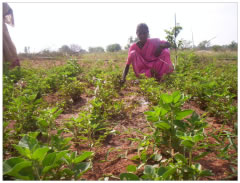
Two months old crop

Field view
Manuring
The crop is mainly grown on residual fertility. Hence, no manure or fertilizers are recommended.
After cultivation
Hand weeding is generally done at 30 days of sowing to control the weeds.
Plant protection
Leaf blight and die back- Diethane M 45(0.3%)
Damping off and seedling rot- Trichoderma viride (2 kg/ha) and Pseudomonas flurescens (2kg/ha)
Harvest
The maturity of the crop is judged by the drying of the leaves and berries turning red. The crop is ready for harvest in 150-170 days after sowing, starting from January upto march. The entire plant is uprooted and roots are separated by cutting the stem 1-2cm above the crown.
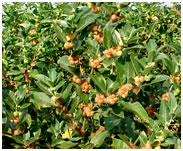
Maturity stage
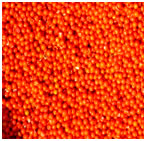
Fresh fruits
Post harvest practices
The roots are transversely cut into smaller pieces of 7-10 cm to facilitate drying. The berries are harvested separately, dried and threshed to remove the seeds.
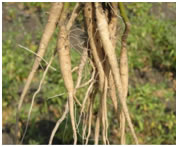
Freshly harvested roots
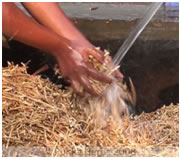
Washing the roots
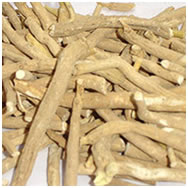
Dried roots

Dried seeds
Grading of roots
The dried roots are beaten with a club to remove adhering soil and to break off thin, brittle, lateral rootlets. Lateral branches, root crown and stem remains are carefully trimmed with a knife. Root pieces are then sorted out into following grades.
1) A grade
Root pieces up to 7 cm in length, 1-1.5 cm in diameter, solid cylindrical with smooth external surface and pure white from inside.
2) B grade
Root pieces up to 5 cm in length, 1 cm or less in diameter, solid, brittle and white from inside.
3) C grade
Solid root pieces up to 3-4 cm in length, 1 cm or less in diameter.
4) D grade
Small root pieces, semisolid or hollow, very thin, yellowish inside and < 1 cm in diameter.
of late farmers are grading the roots into 7 or more grades.
Yield: The crop produces 400-1200 kg/ha dried roots and 200-500 kg seeds/ha.
Source:http://horticulture.kar. nic.in/APMAC_website_files/Ashwagandha.htmhttp://www.bioinfo.in/uploadfiles/13394987433_2_12_JP.pdf
|
